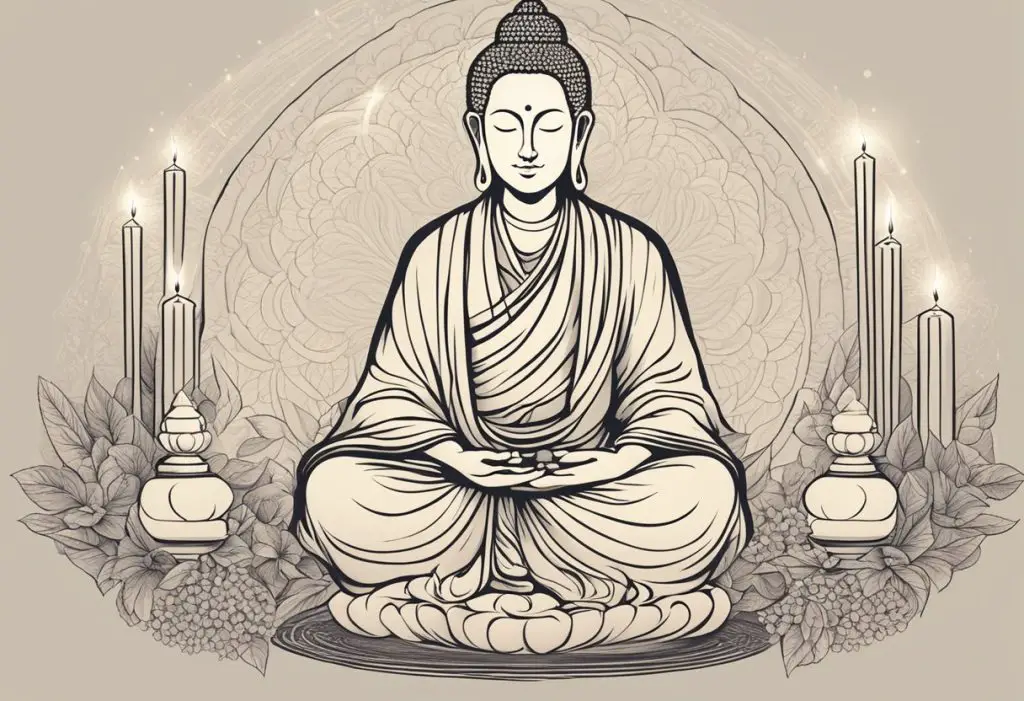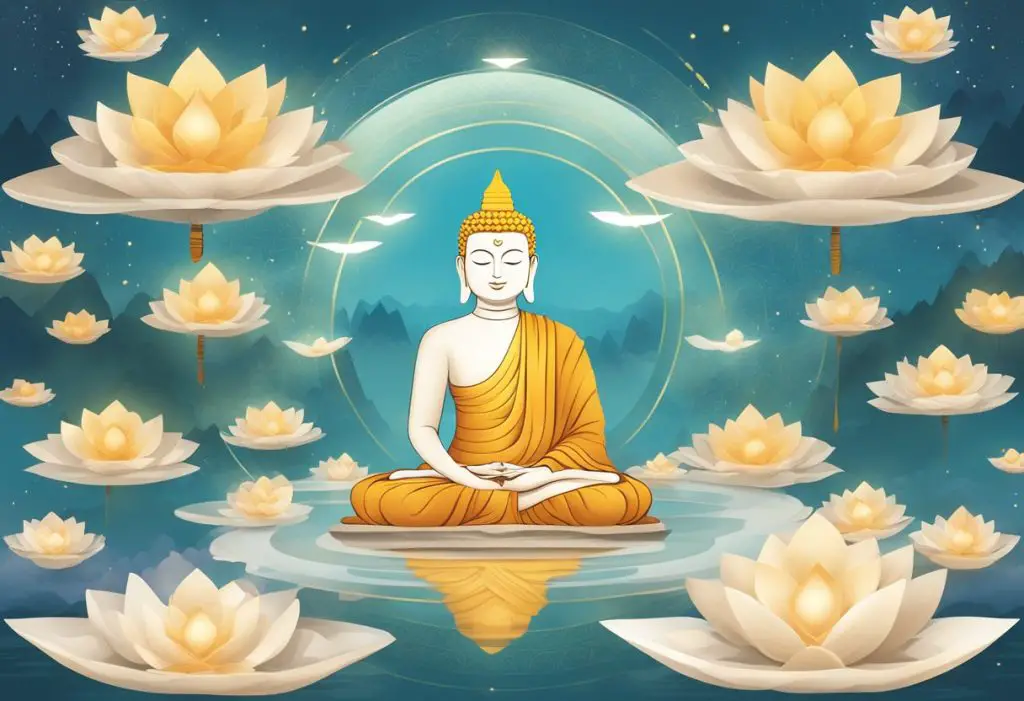Buddhist meditation mantras hold a significant place within the practice of meditation in the Buddhist tradition. They serve as focal points for meditation, often with the aim of cultivating spiritual awareness and inner peace. The repetition of these mantras is not simply a verbal activity; it is a form of mental exercise that helps practitioners concentrate their minds and maintain mindfulness, thereby deepening their meditation experience.

Mantras are short, sacred phrases that carry specific spiritual significance in Buddhism. They can be vocalized aloud or silently repeated in the mind and are utilized across various Buddhist schools. The use of mantras is believed to purify the mind, protect from negative influences, and connect the practitioner to the deeper aspects of consciousness.
During meditation, the recitation of mantras aids in the development of concentration and the stabilization of awareness. As individuals engage with these syllables, they can experience a greater sense of clarity and focus. Incorporating mantras into meditation practice is traditionally thought to help transcend ordinary thought patterns, leading to transformative insights that embody the essence of Buddhist teachings on compassion, impermanence, and interconnectivity.
Historical Context of Buddhist Mantras

Buddhist mantras have a storied past, deeply woven into the fabric of the religion’s development and the spiritual practices of its adherents. These sacred phrases, often composed in Sanskrit, have been used for centuries to focus the mind and connect practitioners with deeper spiritual realities.
Origin and Evolution
The practice of repeating mantras originated over two thousand years ago. Early mantras were composed in Sanskrit, which is considered a sacred language within Buddhism. They are thought to have originated soon after the lifetime of the Buddha, Siddhartha Gautama, as a means to preserve his teachings and aid in meditation. Over the centuries, these mantras evolved, integrating local linguistic and cultural elements, as Buddhism spread from India to various parts of Asia.
One of the most renowned mantras related to Avalokitesvara, the Bodhisattva of compassion, is “Om Mani Padme Hum.” Its use was popularized by Buddhist masters, including Padmasambhava who is revered for bringing Buddhism to Tibet. In Tibetan Buddhism, mantras are considered powerful tools for transforming the mind and are incorporated into many spiritual practices.
Significance in Buddhist Traditions
In Buddhist tradition, mantras are much more than mere sequences of words; they are viewed as manifestations of spiritual presence. Pronunciation of mantras is believed to invoke the energy associated with a particular deity or enlightened being, thereby imbuing the practitioner with their qualities.
- Focus: Mantras concentrate the mind during meditation, reducing distractions.
- Spiritual connection: Chanting connects the practitioner to the lineage of teachers and enlightened beings.
- Ritual use: Mantras are central to various rituals, symbolizing a practitioner’s commitment to Buddhist principles.
Different traditions emphasize different mantras. For instance, in Nichiren Buddhism, the mantra “Nam Myoho Renge Kyo” is chanted, reflecting the deep reverence for the Lotus Sutra, one of the most important texts in Mahayana Buddhism. These mantras, time-tested and spiritually imbued, continue to play a vital role in the daily lives of Buddhists worldwide.
Foundational Concepts

In Buddhist meditation, mantras serve as a critical tool for focusing the mind and fostering a deeper practice. They are integral to the pursuit of enlightenment and mental clarity.
Understanding Mantras
Mantras are phrases or syllables chanted repeatedly during meditation. Om Mani Padme Hum is one of the most widely recognized mantras in Buddhism. It is believed to contain transformative power and is often associated with the embodiment of compassion. These sacred utterances are designed to entrain the practitioner’s consciousness towards a heightened state of awareness.
- Pronunciation: Careful articulation of each mantra enhances its effect.
- Repetition: Continuous recitation reinforces the mantra’s impact on the mind.
- Intention: The purpose behind the chant contributes to its potency.
Role in Meditation
During meditation, mantras act as focal points for the mind, aiding in the cultivation of mindfulness and inner peace. They are tools that practitioners use to ground themselves in the present moment and redirect their attention from distracting thoughts.
- Mental Focus: A mantra can help stabilize the mind, anchoring it in the present.
- Inner Peace: Regular mantra practice can lead to a sense of calm and emotional stability.
- Awareness: As concentration deepens, awareness expands, allowing for a greater sense of interconnectedness with all beings.
Mantras and meditation together create a synergy that can lead to profound mental shifts and the potential for enlightenment.
Key Buddhist Mantras and Their Meanings

Buddhist mantras are spiritual tools revered in Buddhist practice. They are recited to purify the mind, cultivate positive qualities, and connect with divine energies.
Om Mani Padme Hum
The mantra Om Mani Padme Hum is associated with Chenrezig, the Bodhisattva of compassion. Each syllable in this mantra correlates with a particular aspect of the spiritual path. The mantra translates to “the jewel is in the lotus,” symbolizing the potential for purity and enlightenment inherent in every sentient being.
Shakyamuni Mantra
The Shakyamuni Mantra pays homage to the historical Buddha, Siddhartha Gautama. It is recited as “Om Muni Muni Mahamuni Shakyamuniye Soha” and acknowledges Shakyamuni as a great sage. Recitation is believed to enhance wisdom and understanding of his teachings.
Amitabha Mantra
The Amitabha Mantra is integral to Pure Land Buddhism. Reciting “Om Amitabha Hrih” helps practitioners focus on Amitabha Buddha, the Buddha of Infinite Light, and aspire to be reborn in the Pure Land where attaining enlightenment is believed to be easier.
Chenrezig Mantra
Chenrezig, often depicted with multiple arms, is the embodiment of compassion. His mantra, “Om Mani Padme Hum,” mentioned earlier, is central to his practice, and its recitation is meant to invoke his compassionate and loving nature.
Green Tara and White Tara Mantras
Green Tara and White Tara are important female deities in Tibetan Buddhism, representing active compassion and maternal care. The Green Tara mantra, “Om Tare Tuttare Ture Soha,” asks for her swift action in overcoming obstacles. The White Tara mantra, “Om Tare Tuttare Ture Mama Ayuh Punya Jñana Pushtim Kuru Soha,” is recited for longevity, merit, and wisdom.
Practical Application
Integrating Buddhist mantras into one’s daily practice can enhance focus and intent. This section provides specific ways to apply mantras, highlighting daily routines and tailored uses for personal growth and well-being.
Incorporating Mantras in Daily Practice
Incorporating mantra meditation into a daily routine ensures consistency and can cultivate a compassionate nature. Practitioners often begin with choosing a particular time of day, like morning or evening, to recite mantras. Daily Mantra Practice could look like this:
- Morning: A mantra for awakening and setting intentions for the day.
- Midday: A brief mantra session to reconnect with one’s inner calm.
- Evening: Mantras reflecting on gratitude to foster happiness before sleep.
Creating a dedicated space for practice, even if it is a small corner of a room, can help establish a consistent routine. Regular mantra recitation can lead to greater peace and success in one’s spiritual and personal life.
Mantras for Specific Purposes
Each mantra serves a distinct purpose, and one may select mantras based on personal goals or needs. Below are examples of specific mantras and their associated purposes:
| Mantra Purpose | Example of Mantra | Benefits Sought |
|---|---|---|
| Health | Om Tare Tuttare Ture Soha | To promote healing and vitality |
| Protection | Om Benza Wiki Bitana Soha | For shielding from negative influences |
| Blessing | Om Mani Padme Hum | To invite universal love and compassion |
| Happiness | Om Ah Ra Pa Tsa Na Dhi | To enhance joy and contentment in life |
By reciting specific mantras with intent, practitioners aim to harness the energy of these powerful phrases to bring about tangible effects in their lives. It’s important to approach each mantra with respect and clarity to maximize its impact.
Mantras and Mindfulness
Buddhist meditation mantras are integral to enhancing mental focus and cultivating mindfulness. They facilitate a heightened level of awareness during meditation practices.
Integration with Mindfulness Practices
Mantras serve as a powerful tool in mindfulness practices. They are phrases or sounds repeated during meditation that bring the practitioner’s attention to the present moment. This repetition aids in anchoring the mind, diminishing wandering thoughts, and fostering a state of mindful awareness. For instance, the mantra “Om Mani Padme Hum” is traditionally used to purify the mind and body, focusing the meditator’s consciousness on the here and now.
Enhancing Concentration and Focus
The use of mantras significantly increases concentration. Repetition of a mantra can create a singular point of focus, simplifying the mental landscape and allowing for deeper meditation. This practice often leads to reduced stress levels as the meditator’s attention moves away from distracting thoughts. Through consistent use, mantras can strengthen concentration, assisting practitioners in achieving a prolonged state of focus during their mindfulness exercises.
Psychological and Emotional Benefits
Buddhist meditation mantras offer profound psychological and emotional benefits, targeting the relief of stress and anxiety while fostering emotional balance and healing.
Coping with Stress and Anxiety
Meditation mantras are a key tool in the reduction of stress levels and anxiety. Chanting or mentally repeating these phrases can bring about a state of mindfulness, anchoring one’s attention in the present moment and diminishing the impact of stressors.
- Stress Reduction: Studies indicate that mantra repetition helps lower cortisol, the stress hormone, thus reducing overall stress.
- Anxiety Alleviation: Through consistent practice, individuals report a decrease in anxiety symptoms, as mantras promote a sense of calm and inner peace.
Mantras for Emotional Balance and Healing
Mantras in Buddhist meditation can aid in emotional healing and balance. They serve as a means to navigate emotional turbulence and facilitate the healing process for those coping with depression and emotional distress.
- Emotional Stability: Engaging with mantras can equilibrate emotional responses, mitigating feelings of emotional overwhelm.
- Depression Management: For some individuals, mantras contribute to improving mood and may complement other treatments for depression.
- Healing: The repetitive nature of mantras fosters an environment conducive to self-reflection and emotional release, which are vital components of the healing journey.
Physical and Spiritual Health
Meditation mantras in Buddhism are deeply connected to enhancing both physical and spiritual well-being. They are considered tools for healing and growth, and can be integrated into daily spiritual practices.
Mantras for Physical Well-being
Mantras are used within Buddhist traditions to promote physical health by reducing stress and facilitating a state of calm. Regular chanting of these mantras is believed to improve the practitioner’s mental state, which in turn can lead to better physical health outcomes.
- Om Mani Padme Hum: This mantra is said to invoke the powerful benevolent attention and blessings of Chenrezig, the embodiment of compassion.
- Om Tare Tuttare Ture Soha: It is dedicated to Tara, the mother of all Buddhas, and is often used for health and longevity.
Both mantras are recited with the intention of bringing about healing and longevity, with a focus on the interconnection of mind and body.
Cultivating Spiritual Growth
Spiritual growth is a key objective of Buddhist practices, with mantras serving as aids in the pursuit of enlightenment. Mantras help in focusing the mind and opening the heart, fostering the development of beneficial qualities that are essential to spiritual progress.
- Om Muni Muni Mahamuni Shakyamuniye Soha: This mantra, paying homage to the Buddha Shakyamuni, is chanted to purify the mind, enhance wisdom, and deepen understanding.
- Om Ah Ra Pa Ca Na Dhih: Recitation of this mantra enhances wisdom by invoking the presence of the bodhisattvas, cultivating the mental fortitude necessary for spiritual growth.
Regular recitation of these mantras is considered a potent method for cultivating qualities like compassion, wisdom, and a greater sense of peace—essential aspects of a Buddhist’s spiritual path.
Mantras and Community
In the context of Buddhist practices, mantras serve as a bridge, connecting individual practice with the wider community. Chanting collectively reinforces shared values and the focus on compassionate living.
Chanting in Groups
Buddhist communities often come together to chant mantras, a practice that can strengthen the collective energy and intention. The repetition of sacred phrases in unison, such as “Om shanti shanti shanti,” signifies the group’s homage to peace. Chanting in groups is more than a practice; it’s a communal sharing of vibrations and intentions. The mantra here works as a catalyst, fostering a sense of unity and shared spirituality within the community.
- Purpose:
- Reinforce community bonds
- Amplify collective intentions
- Common Group Mantras:
- Om shanti shanti shanti (Peace)
- Sabbe satta sukhi hontu (May all beings be happy)
Mantras for Peace and Compassion
Community mantras often focus on nurturing peace and compassion within and among individuals. “Sabbe satta sukhi hontu,” translating to “may all beings be happy,” exemplifies the loving intention Buddhists extend towards all living entities. This reflects the heart of Buddhist practice, where peace and compassion are not just concepts but are actively cultivated through mantra repetition. Each utterance is like a collective blessing, wishing happiness and loving-kindness to all.
- Core Values Reflected in Mantras:
- Compassion towards all beings
- Desire for universal peace
- Impact of Compassionate Mantras:
- Promote altruism within the community
- Inspire acts of loving-kindness
Advanced Practices
In advanced Buddhist practices, precise and consistent recitation of mantras is often tied to complex rituals and visualizations. Mastery is said to bring about profound transformation and realization.
Sadhana and Mantra Recitation
Buddhist sadhana refers to a methodical practice that includes mantra recitation, meditation, and visualization, aiming for spiritual accomplishments. For example, Tibetan Buddhists incorporate sadhanas into their daily practice rigorously, often committing to hundreds or thousands of recitations. The mantras are central to the efficacy of these practices, with Vajrasattva mantra being a key component for purification. Specialists might use a mala (a string of beads) for tracking recitations, ensuring precise adherence to the prescribed number.
| Sadhana Component | Purpose |
|---|---|
| Recitation of Mantras | Invokes specific energies |
| Meditation | Integrates the energies |
| Visualization | Personalizes the experience |
Devotion and a sincere commitment are seen as critical for success in these practices.
Mantras in Esoteric Buddhism
In Esoteric Buddhism, found in traditions like Nichiren Buddhism, advanced mantra practices are considered extremely potent. These mantras encapsulate the essence of a deity or a profound concept. Practitioners invoke Vajrapani, the bodhisattva representing the power of all Buddhas, for spiritual strength. Recitation, in this context, is not only about vocalizing the mantra but also embodying its meaning.
- Nichiren Buddhists often fervently chant the mantra “Nam-myoho-renge-kyo”, expressing deep devotion to the Mystic Law.
Advanced mantra practices in Buddhism are multifaceted and demand a great deal of discipline and understanding, often taking years of dedicated practice to master.
Tools and Aids for Mantra Meditation

For an effective mantra meditation practice, certain tools and aids can enhance concentration and spiritual experience. These aids facilitate a deeper connection with the mantra’s vibrational qualities and align them with the body’s energy centers.
Use of Mala Beads
Mala beads are a traditional tool used to keep count during mantra recitation. A mala typically consists of 108 beads plus one ‘guru bead’ to indicate the start and end of a cycle.
- Material: Common materials include rudraksha, sandalwood, or gemstones.
- Usage: The user holds the mala in one hand and uses the thumb to ‘pull’ each bead through the fingers with each repetition of the mantra.
This tangible form of keeping count aids in maintaining focus and establishes a rhythm to the meditation practice.
Integration with Yoga and Chakras
Yoga can be a complementary practice to mantra meditation, where specific postures (asanas) help in aligning and opening the chakras, which are the body’s energy centers.
- Chakras: There are seven main chakras, each associated with different aspects of physical, emotional, and spiritual well-being.
- Yoga-Mantra Synergy: Certain mantras correspond to specific chakras, and incorporating them into yoga can enhance the flow of energy.
The combination of yoga postures with the vibrations of mantras greatly enhances the meditator’s concentration and spiritual journey.
Overcoming Challenges
In the practice of Buddhist meditation mantras, one often encounters specific hurdles. Recognizing and addressing these challenges is crucial for a steady and rewarding meditation journey.
Dealing with Distractions
Distractions are an inevitable part of meditation practice. Whether they are external, such as noises, or internal, like wandering thoughts, they can impede concentration and control. One tactic is the use of anchoring phrases—mantras that can bring the mind back to focus. Practitioners might find it beneficial to note distractions without attachment and redirect their awareness to the mantra.
| Type of Distraction | Strategy |
|---|---|
| External | Select a quiet environment or use earplugs |
| Internal | Acknowledge gently and return to mantra |
Through persistent effort and heightened awareness, individuals can minimize the impact of distractions over time.
Breaking Through Plateaus
A plateau can manifest either as a mental or physical stagnation in practice. These periods of apparent lack of progress require perseverance and may demand a re-evaluation of one’s approach. One may adjust their technique by experimenting with different sitting positions to alleviate physical discomfort, or introduce new mantras to reignite mental engagement.
Subsequent Strategies:
- Vary Mantra Intensity: Alternating between soft and more pronounced recitations can help maintain interest and concentration.
- Incremental Progress: Setting achievable, incremental goals can pave the way for longer-term success and control over the meditation practice.
By applying these targeted strategies, practitioners are better equipped to overcome the challenges that arise on the path of meditation with mantras.
Mantras for Personal Development
In the context of Buddhist meditation, certain mantras are believed to be particularly powerful for personal growth, aiding in achieving worldly success and fostering spiritual wisdom.
Achieving Success and Abundance
Buddhist practitioners often recite mantras with the intention of attracting positive energy and prosperity. The Sanskrit mantra “Om Vasudhare Svaha” is dedicated to Vasudhara, the goddess of wealth in Buddhist tradition. Chanting this mantra is thought to increase abundance and success in one’s personal and professional life.
Practical application:
- Chant daily: Aim for 108 recitations.
- Focus on intent: While chanting, visualize success and abundance.
Fostering Wisdom and Enlightenment
For the cultivation of wisdom and enlightenment, the mantra “Om Mani Padme Hum” is central within Buddhist practices. It is believed that its recitation purifies the mind, removes obstacles to mental growth, and helps the practitioner accumulate merit, which is essential for spiritual development.
Key aspects:
- Mental clarity: Regular chanting promotes a clear mindset.
- Enlightenment path: Said to enhance the quality of practice towards spiritual awakening.
Boldly integrating these mantras into one’s Buddhist practice can potentially lead to a transformational journey marked by both material and spiritual elevation.
Mantras in Modern Context
Buddhist mantras have transcended their traditional settings, finding a place within the fabric of global modernity. They have adapted to contemporary lifestyles while maintaining their essence.
Adaption and Integration
Buddhist mantras have been seamlessly woven into the tapestry of modern life, adapting to new contexts while retaining their spiritual significance. They are utilized in meditation centers worldwide, often framed in non-sectarian or secular mindfulness practices to appeal to a broader audience. Adaptation has been key; integrating these mantras into stress relief apps and wellbeing programs is commonplace.
Examples of Integration:
- Mindfulness Apps: Mantras feature in guided meditation sessions, with instructions in various languages.
- Wellness Programs: Mantras are incorporated into corporate wellness initiatives to enhance employee mental health.
- Yoga Practices: Integration of mantras in yoga classes, amplifying the spiritual aspect of physical exercise.
Global Influence and Future Prospects
The global influence of Buddhist mantras is evident in their role within international wellness movements. The mantras have been embraced by people of diverse cultural backgrounds, contributing to their growth and continued relevance. These practices no longer remain confined to Buddhist practitioners but have found a universal audience seeking spiritual sustenance.
Future Projections:
- Educational Sphere: Their inclusion in curricula focusing on emotional intelligence and mindfulness.
- Interfaith Dialogues: Mantras’ role in promoting cross-cultural understanding and spiritual exploration.
The future prospects for Buddhist mantras suggest sustained growth, as they offer a timeless tool for navigating the complexities of modern existence.
